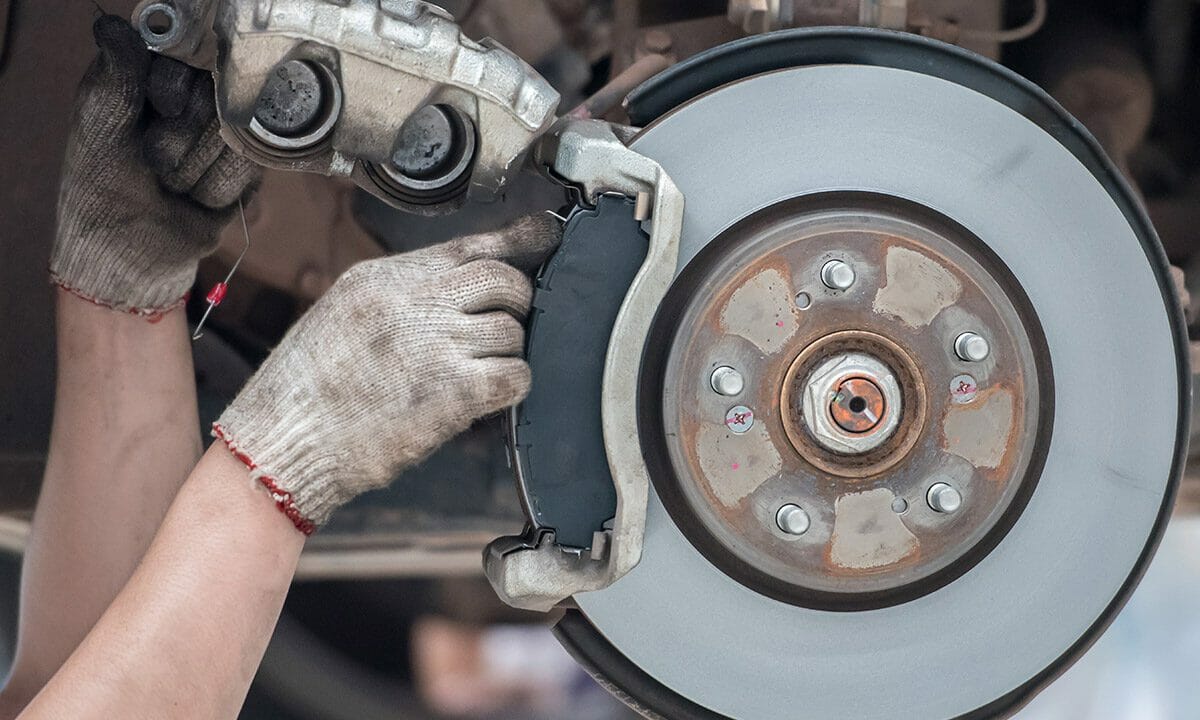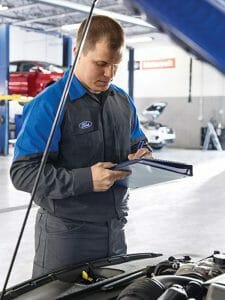
Most of us take our vehicles for granted because of their complexities. However, it is our job as a responsible car owner to know the warning signs of a problem and when to get our vehicle looked at.
Your Brakes’ Anatomy
Today, cars universally use hydraulics to apply the brakes. When you press the pedal, a plunger depresses in the master cylinder, moving the pressurized fluid. The fluid’s increase pressure moves through the brake lines and compresses each wheel’s cylinder.
Early cars used a set of cables and pulleys to get the pressure from your pedal to the wheels. However, mechanical lines needed far more maintenance and precision. Brake wires could snap when you needed them most. Or they could send each cylinder different pressures. Since the 1950s, hydraulics became the standard in production cars for their safety and durability.
But what are the brakes themselves? As you could guess, their role is to transfer the kinetic energy in the wheels into heat through the brake’s friction with the wheel. But we are not just scraping metal against metal at highway speeds.
To save the wheel from the wear that would come from just pushing metal against metal, cars use one of two solutions. The first are drum brakes. To assist with braking, a drum is attached to the wheel. Heat-resistant braking pads press up against the drum, which in return stops the wheel.
We used drum brakes up through the 80s. And we still do. Their one downside is that they heat up with frequent stopping and intense conditions. Stopping a speeding car can heat your brakes to as much as 950° F. When they get too hot, they have less available energy left to transfer from the motion in the wheels. They are safe for the most part, and we still do have them on many cars, but an alternative was made.
Disc brakes solved the issue of heating up. Beyond an increased friction coefficient, attaching disc brakes to the wheel means pushing out instead of in. Plus, disc brakes increase the surface area that applies the friction. The discs, open to the air, cool off faster and dissipate the heat.
Since the 80s, disc brakes started appearing in cars that would reach greater heats. But drum brakes are more than adequate for lighter or entry cars. It is a good idea to know what brakes your vehicle uses.
Brake Failure
It is a rare occurrence for brakes to suddenly fail. This is the worst-case scenario. Usually, bringing your car into your Ford dealership for brake repairs involved them wearing down from use. You will luckily be able to know this is happening with warning signs. Manufacturers put indicators, different materials, in the brake pads and discs so that when you get down to them, your brakes make noise.
No one needs to have the importance of having properly functioning brakes in their car. It is not only crucial as a safety feature but essential for driving the vehicle itself. If you receive any warning signs that your brakes need service, then you should not hesitate to get your car into the shop. You cannot wait until they stop working in the middle of you driving.
When to get your brakes checked?
Your check brake light is the first sign you might receive its time to have your brakes worked on. One of the easiest signs your car will give you is what your manufacture leaves you. Cars are now required to have a smart monitoring system. Your light could tell you to come in for an inspection where your entire brake system will be checked. Or your smart electronics could be sensing a problem. Make sure that your parking brake is not depressed and triggering the light and be sure to read up on the meaning of each dashboard indicator.
Making Noise
The next most common indicator that your brakes are wearing down is that they are making noise. Rattling, screeching, squealing, grinding, or squeaking can all mean your brakes need work. If you experience a high-pitched, metallic squeal while you drive, this likely means that your brake pads have been worn down. As mentioned before, the brake pads have steel indicators that, when in contact with the rotors, will emit a squeal.
On the other hand, grinding when you apply the brakes could mean several things. If you can feel it as you hit the brakes, there may be a rock or some gravel in the caliper. It is also possible that there is a lack of lubrication on rear drum brakes. If you went too long without servicing your brakes, your brake pads might be completely worn through, and you hear metal against metal.
Addressing these kinds of issues as they come up can save you from more expensive costs. Letting these go, having brake discs, drums, and wheels scrape against each other could mean you have to replace the rotor, instead of just the pads.
Bumpy Braking
If your vehicle starts vibrating when you apply the brakes, then it may mean you have an uneven rotor. The brake rotors that fit inside the wheel need to be uniform to use the right pressure all the way around. It has to be exact to thousandths of an inch. Over normal wear and tear, they will develop slight variations. When you get your brakes serviced, your rotors should get trued.
It is also possible that your brake caliper is not working correctly. Your brake caliper is what squeezes your brake pads to the rotor and slows you down. The piston inside the caliper causes it to squeeze down and apply the friction. Over time, the heat and road debris can cause the piston to stick. This means the caliper will not go back to the full off position as you let go of the brake pedal.
There are other possibilities, though. Wobbling during braking can also come from loose lug nuts on your wheel. Vibrating when you drive, especially at high speeds over 50, is more likely a wheel alignment problem than a brake problem.
Soft Brake Pedal
If your brakes are slower and softer than usual, then you may have a brake fluid leak. You should get this checked immediately. While you know where your brake fluid reservoir is, it could be leaking from the master cylinder or anywhere in the brake system. You should have one of our factory-trained service technicians look for the leak.
Your brake should not go all the way to the floor. In vehicles with automatic brakes, your pedal should stop at least an inch above the floor of your car, and with manual brakes, they should stay at three inches. If your pedal feels spongy when applying it or sinks when pressing it, you may have air or moisture in the brake system.
Having grease or oil on your brakes will also render them inert. The slick oil or grease reduces the friction it takes to make the stop. Your Ford technician will make sure your brake system is clean and sticks appropriately.
Pulling to One Side
If your car is leaning in one way every time you brake, it means each brake is receiving uneven pressure one way or another. It could be a matter of one of the calipers or something wrong with the brake hose. Either way, it is a dangerous way to drive and only gets worse, so you should take it to get serviced right away.
Overheated or Smoking
If you start to smell a sharp chemical odor after you repeated sharp brakes, pull over and get out of the car. You want to check that your parking brake has been released. Then, you should wait till your brakes cool. With overheated brakes, the “hot spots” between the rotor and pads resist friction. And without resistance, they cannot grip one another.
If smoke is coming from any of your wheels, it could mean a stuck caliper and is unsafe to drive on.
Your Ford Dealership
Regardless of any of these warning signals, you should make sure to get an inspection every six months or 6,000 miles at a minimum. It is one of the utmost important safety mechanisms in your vehicle. And there is no greater place to trust than the dealer you drove your car off the lot of.
We hire over 35,000 Ford factory-trained service technicians nationwide. They specialize in serving your car, truck, or SUV. Because of their training with us, they have the knowledge and experience with your vehicle’s original equipment manufacturer (OEM) parts. Your brake system checkup with your Ford technician will include a check for:

- Uneven wear and measure brake pad/shoe thickness
- Calipers for wear or sticking
- Test hardware and make adjustments
- Ensure brake lines and master and wheel cylinders are not leaking
- Rotors for hot spots and run-outs
- Anti-lock brake sensors
- Brake fluid levels and conditions.
Plus, our dealership service station includes the benefits of:
- Full-service maintenance
- Parts and labor warranties
- Clean, comfortable waiting areas
- Wi-Fi
- Shuttle service to and from your home
- Friendly knowledgeable staff
For brake repairs or an inspection, contact your local Ford dealer for our current service promotions and coupons. Or you can log in to your Ford Owner account and schedule an appointment with us.